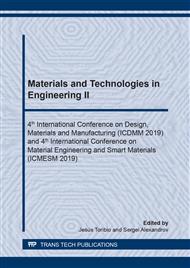p.3
p.9
p.18
p.24
p.33
p.41
p.50
p.55
Studying the Effect of Fine Particles of Tungsten Carbide on the Macro-Structure, Hardness and Microhardness of Gradient Steel Billets
Abstract:
Creating a gradient of properties in a single material is challenging for scientists and engineers. For this purpose, such methods are used as: welding of steels of different chemical compositions, joint rolling of steel sheets, sealing and surfacing of various kinds. All of these methods have a big disadvantage: under load, the material is destroyed in the weakest place - the place where the layers join. In this article, the authors proposed to obtain a gradient of properties in steel castings due to the introduction of dispersed particles of tungsten carbide into the crystallizing melt during centrifugal casting. The particles introduced serve as crystallization centers, accelerate the crystallization process and increase certain types of mechanical properties (hardness, microhardness, tensile strength). In addition, the particles of tungsten carbide have high hardness; therefore, in the structure of the workpieces they serve as reinforcing elements that strengthen the structure. The uneven distribution of particles in the preform being formed is possible for two reasons: tungsten carbide has a density greater than the melt, and besides, centrifugal force acts on them. The article describes the experiment and its results on the production of metal preforms with a gradient of properties. The introduced particles significantly influenced the macro-structure of the prepared castings. The article also presents the results of a study of the effect of particles on the hardness and micro-hardness of the resulting blanks.
Info:
Periodical:
Pages:
3-8
Citation:
Online since:
April 2020
Authors:
Price:
Сopyright:
© 2020 Trans Tech Publications Ltd. All Rights Reserved
Share:
Citation:


